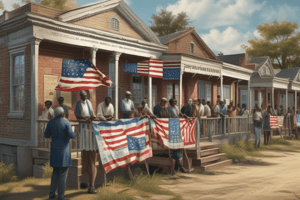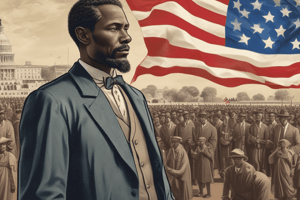Podcast
Questions and Answers
What were the two main goals of Reconstruction?
What were the two main goals of Reconstruction?
- To rebuild the country and to ensure the main goals were achieved. (correct)
- To rebuild the country and to ensure the South was punished.
- To rebuild the country and to ensure African Americans were granted citizenship.
- To rebuild the country and to guarantee equal rights for all.
Which of the following was NOT a method used to prohibit African Americans from voting?
Which of the following was NOT a method used to prohibit African Americans from voting?
- The 15th Amendment (correct)
- Poll taxes
- Grandfather clauses
- Literacy tests
What was the outcome of the Plessy v. Ferguson case?
What was the outcome of the Plessy v. Ferguson case?
- It legalized segregation. (correct)
- It granted African Americans the right to vote.
- It declared Jim Crow laws unconstitutional.
- It ended Reconstruction.
Which of the following was a 'push' factor for westward expansion?
Which of the following was a 'push' factor for westward expansion?
Which of the following was NOT a way the federal government encouraged settlement of the West?
Which of the following was NOT a way the federal government encouraged settlement of the West?
What did the Dawes Act attempt to do?
What did the Dawes Act attempt to do?
How did the Radical Republicans' plan for Reconstruction differ from President Johnson's plan?
How did the Radical Republicans' plan for Reconstruction differ from President Johnson's plan?
Which of the following amendments granted citizenship to all persons born or naturalized in the US?
Which of the following amendments granted citizenship to all persons born or naturalized in the US?
What was the primary purpose of Native American boarding schools?
What was the primary purpose of Native American boarding schools?
Which of these statements is TRUE about the Compromise of 1877?
Which of these statements is TRUE about the Compromise of 1877?
Which of the following muckrakers exposed the horrible conditions of immigrants in NYC and led to the passing of laws like the Meat Inspection Act and the Pure Food and Drug Act?
Which of the following muckrakers exposed the horrible conditions of immigrants in NYC and led to the passing of laws like the Meat Inspection Act and the Pure Food and Drug Act?
Which of the following best describes the main difference between the philosophies of Booker T. Washington and W.E.B. DuBois regarding racial equality?
Which of the following best describes the main difference between the philosophies of Booker T. Washington and W.E.B. DuBois regarding racial equality?
Which of the following best describes the relationship between the rapid growth of US industry and US imperialism?
Which of the following best describes the relationship between the rapid growth of US industry and US imperialism?
Which of the following best describes the "Big Stick" Policy?
Which of the following best describes the "Big Stick" Policy?
Which progressive president is most closely associated with the "Trust Busting" movement?
Which progressive president is most closely associated with the "Trust Busting" movement?
What was the primary goal of the settlement houses during the Progressive Era?
What was the primary goal of the settlement houses during the Progressive Era?
Which of the following is NOT a characteristic of progressive reforms?
Which of the following is NOT a characteristic of progressive reforms?
Which amendment extended suffrage (the right to vote) to women?
Which amendment extended suffrage (the right to vote) to women?
What was the imperialistic long-term cause of the Spanish-American War?
What was the imperialistic long-term cause of the Spanish-American War?
Which event sparked the beginning of World War I?
Which event sparked the beginning of World War I?
Which countries were part of the Central Powers during World War I?
Which countries were part of the Central Powers during World War I?
What was President Wilson's initial stance on World War I?
What was President Wilson's initial stance on World War I?
What was one of the major technological advancements used during World War I?
What was one of the major technological advancements used during World War I?
What was a key reason for the United States entering World War I?
What was a key reason for the United States entering World War I?
What was the function of trench warfare in World War I?
What was the function of trench warfare in World War I?
Why did the United States refuse to sign the Treaty of Versailles?
Why did the United States refuse to sign the Treaty of Versailles?
Which factor did NOT contribute to rapid industrialization in the US?
Which factor did NOT contribute to rapid industrialization in the US?
What is one of the negative effects of industrialization?
What is one of the negative effects of industrialization?
What was a primary goal of labor unions during the industrial era?
What was a primary goal of labor unions during the industrial era?
What was the federal government’s stance on labor unions during the industrial era?
What was the federal government’s stance on labor unions during the industrial era?
How were industrialists like John D. Rockefeller viewed?
How were industrialists like John D. Rockefeller viewed?
Which of the following is a push factor encouraging immigration to the US?
Which of the following is a push factor encouraging immigration to the US?
What is the definition of nativism?
What is the definition of nativism?
What was a reason for immigrants being detained at Ellis Island?
What was a reason for immigrants being detained at Ellis Island?
Flashcards
What is a muckraker?
What is a muckraker?
A person who exposes societal issues through writing and investigations, often in a sensationalized manner.
What laws were passed because of Upton Sinclair's "The Jungle"?
What laws were passed because of Upton Sinclair's "The Jungle"?
The Meat Inspection Act, which ensured the safety of meat production, and the Pure Food and Drug Act, which improved food and medicine safety.
What was Roosevelt's "Big Stick" policy?
What was Roosevelt's "Big Stick" policy?
This policy aimed to protect American economic interests abroad by using diplomacy and military force.
What was Taft's "Dollar Diplomacy"?
What was Taft's "Dollar Diplomacy"?
Signup and view all the flashcards
What was Wilson's "Moral Diplomacy"?
What was Wilson's "Moral Diplomacy"?
Signup and view all the flashcards
What is "Self-Determination"?
What is "Self-Determination"?
Signup and view all the flashcards
How did Booker T. Washington and W.E.B. DuBois differ in their views on racial equality?
How did Booker T. Washington and W.E.B. DuBois differ in their views on racial equality?
Signup and view all the flashcards
What were settlement houses?
What were settlement houses?
Signup and view all the flashcards
13th Amendment
13th Amendment
Signup and view all the flashcards
14th Amendment
14th Amendment
Signup and view all the flashcards
15th Amendment
15th Amendment
Signup and view all the flashcards
Jim Crow Laws
Jim Crow Laws
Signup and view all the flashcards
Compromise of 1877
Compromise of 1877
Signup and view all the flashcards
Plessy v. Ferguson
Plessy v. Ferguson
Signup and view all the flashcards
Assimilation of Native Americans
Assimilation of Native Americans
Signup and view all the flashcards
Homestead Act
Homestead Act
Signup and view all the flashcards
Push and Pull Factors of Western Expansion
Push and Pull Factors of Western Expansion
Signup and view all the flashcards
Dawes Act
Dawes Act
Signup and view all the flashcards
Industrialization
Industrialization
Signup and view all the flashcards
Urbanization
Urbanization
Signup and view all the flashcards
Laissez-faire
Laissez-faire
Signup and view all the flashcards
Nativism
Nativism
Signup and view all the flashcards
Push factors of Immigration
Push factors of Immigration
Signup and view all the flashcards
Pull factors of Immigration
Pull factors of Immigration
Signup and view all the flashcards
Goals of labor unions
Goals of labor unions
Signup and view all the flashcards
Child Labor during industrialization
Child Labor during industrialization
Signup and view all the flashcards
Assassination of Archduke Franz Ferdinand
Assassination of Archduke Franz Ferdinand
Signup and view all the flashcards
Alliance System in WWI
Alliance System in WWI
Signup and view all the flashcards
Militarism in WWI
Militarism in WWI
Signup and view all the flashcards
Treaty of Versailles
Treaty of Versailles
Signup and view all the flashcards
Nationalism in WWI
Nationalism in WWI
Signup and view all the flashcards
Zimmerman Telegram
Zimmerman Telegram
Signup and view all the flashcards
Imperialism in WWI
Imperialism in WWI
Signup and view all the flashcards
Trench Warfare in WWI
Trench Warfare in WWI
Signup and view all the flashcards
Study Notes
US History Unit 1 Review: Reconstruction and Western Expansion
- Reconstruction goals were not fully achieved.
- Differences between President Johnson's and Radical Republicans' plans: Johnson's plan allowed Southern states to run their own governments, while Radical Republicans sought to punish the South. Radical Republicans intended to remove Confederate leaders from power and give African Americans equal rights.
US History Unit 1 Review: Reconstruction Amendments
- 13th Amendment abolished slavery
- 14th Amendment guaranteed citizenship and equal protection
- 15th Amendment gave African American men the right to vote.
US History Unit 1 Review: Methods to Prevent African Americans from Voting
- Poll Taxes: Fees required to vote
- Literacy tests: tests determining if someone could read or write
- Grandfather clauses: requirements that voters' ancestors had voted in the past.
US History Unit 1 Review: The Compromise of 1877
- Laws enforced racial segregation after Reconstruction ended.
- These laws were known as Jim Crow laws.
- Lynching was used to enforce segregation and terrorize African Americans.
US History Unit 1 Review: Plessy v. Ferguson
- Legalized segregation under "separate but equal" doctrine
- Outcome was racial discrimination.
US History Unit 1 Review: Federal Government Encouraged Western Settlement
- Homestead Act
- Railroads aided westward movement
- Federal government helped by giving away land.
US History Unit 1 Review: Federal Government's Attempts to Assimilate Native Americans
- Dawes Act: Federal government tried to assimilate Native Americans by forcing tribes to adopt agricultural lifestyle and surrender land.
Studying That Suits You
Use AI to generate personalized quizzes and flashcards to suit your learning preferences.




